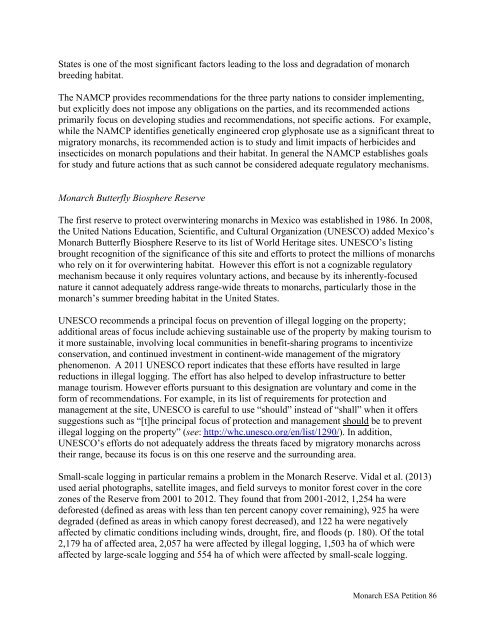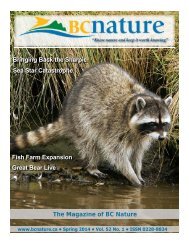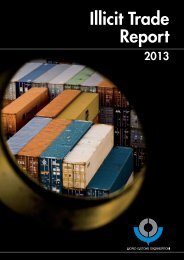monarch-esa-petition-final_61585
monarch-esa-petition-final_61585
monarch-esa-petition-final_61585
Create successful ePaper yourself
Turn your PDF publications into a flip-book with our unique Google optimized e-Paper software.
States is one of the most significant factors leading to the loss and degradation of <strong>monarch</strong><br />
breeding habitat.<br />
The NAMCP provides recommendations for the three party nations to consider implementing,<br />
but explicitly does not impose any obligations on the parties, and its recommended actions<br />
primarily focus on developing studies and recommendations, not specific actions. For example,<br />
while the NAMCP identifies genetically engineered crop glyphosate use as a significant threat to<br />
migratory <strong>monarch</strong>s, its recommended action is to study and limit impacts of herbicides and<br />
insecticides on <strong>monarch</strong> populations and their habitat. In general the NAMCP establishes goals<br />
for study and future actions that as such cannot be considered adequate regulatory mechanisms.<br />
Monarch Butterfly Biosphere Reserve<br />
The first reserve to protect overwintering <strong>monarch</strong>s in Mexico was established in 1986. In 2008,<br />
the United Nations Education, Scientific, and Cultural Organization (UNESCO) added Mexico’s<br />
Monarch Butterfly Biosphere Reserve to its list of World Heritage sites. UNESCO’s listing<br />
brought recognition of the significance of this site and efforts to protect the millions of <strong>monarch</strong>s<br />
who rely on it for overwintering habitat. However this effort is not a cognizable regulatory<br />
mechanism because it only requires voluntary actions, and because by its inherently-focused<br />
nature it cannot adequately address range-wide threats to <strong>monarch</strong>s, particularly those in the<br />
<strong>monarch</strong>’s summer breeding habitat in the United States.<br />
UNESCO recommends a principal focus on prevention of illegal logging on the property;<br />
additional areas of focus include achieving sustainable use of the property by making tourism to<br />
it more sustainable, involving local communities in benefit-sharing programs to incentivize<br />
conservation, and continued investment in continent-wide management of the migratory<br />
phenomenon. A 2011 UNESCO report indicates that these efforts have resulted in large<br />
reductions in illegal logging. The effort has also helped to develop infrastructure to better<br />
manage tourism. However efforts pursuant to this designation are voluntary and come in the<br />
form of recommendations. For example, in its list of requirements for protection and<br />
management at the site, UNESCO is careful to use “should” instead of “shall” when it offers<br />
suggestions such as “[t]he principal focus of protection and management should be to prevent<br />
illegal logging on the property” (see: http://whc.unesco.org/en/list/1290/). In addition,<br />
UNESCO’s efforts do not adequately address the threats faced by migratory <strong>monarch</strong>s across<br />
their range, because its focus is on this one reserve and the surrounding area.<br />
Small-scale logging in particular remains a problem in the Monarch Reserve. Vidal et al. (2013)<br />
used aerial photographs, satellite images, and field surveys to monitor forest cover in the core<br />
zones of the Reserve from 2001 to 2012. They found that from 2001-2012, 1,254 ha were<br />
deforested (defined as areas with less than ten percent canopy cover remaining), 925 ha were<br />
degraded (defined as areas in which canopy forest decreased), and 122 ha were negatively<br />
affected by climatic conditions including winds, drought, fire, and floods (p. 180). Of the total<br />
2,179 ha of affected area, 2,057 ha were affected by illegal logging, 1,503 ha of which were<br />
affected by large-scale logging and 554 ha of which were affected by small-scale logging.<br />
Monarch ESA Petition 86




